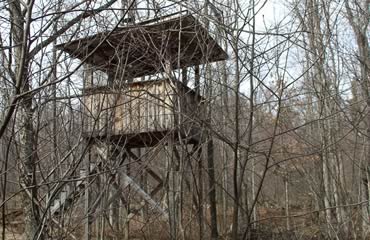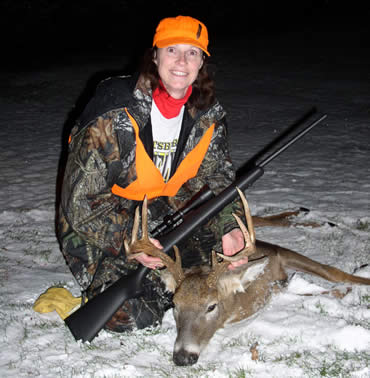By John C. Street
What whitetail hunters need to know about forest habitat.
Eighteen years ago, when the patriarchs of our respective families were approaching their 80th birthdays, my wife Kathy and I built each of them a deer stand. These were not your basic platform-nailed-in-a-tree stands. They were freestanding 8x8s, 12 feet off the ground, with wood burning stoves, second-hand swiveling office chairs and steps with railings.
They were built about 200 yards apart on an open hardwood hillside that sloped off to a creek bottom. Shots often were on the longish side by eastern standards, but both patriarchs filled their tags, often both buck and doe.
The 25 acres where those stands were built had been purchased from a timber company that consented to the sale on the condition they be given three years to take a 12-inch DBH (diameter at breast height) cut. With only a few months left on the agreement, they sent their loggers in to harvest their trees. By the time the chainsaws stopped running several weeks later, the property was nearly unrecognizable.
Unless you’ve lived on a piece of land that’s been timbered, it’s hard to comprehend the visual ugliness and the consequent emotional impact. If you can conjure up images of the aftermath of hurricane Katrina and apply it to a forest, you get the picture. Funny thing, though. Despite our anguish, two months after the saws stopped running, we had one of our best deer seasons ever.
Today, my 25 acres are in what forest managers refer to as the successional stage. The regeneration is so thick it is nearly impossible to shoot more than 50 yards out of either stand. The logging scars, including the muddy skid trails, have all but disappeared and, wonder of wonders, the annual harvest from both stands has gotten progressively better.
Like a lot of people, I suspect, I don’t start paying attention to current events until they have a direct and immediate impact on me. Forest issues, as a poignant for instance, never entered my radar screen until the day the loggers arrived. Since then, I’ve not only been paying attention, but have also learned that ... well, allow me to explain.
 SEEING THE FOREST AND THE TREES
SEEING THE FOREST AND THE TREES
Much has been written of late regarding the debate over state and federal public forests and the way they should be managed. For obvious reasons, those of us who hunt in these forests are being asked to take sides. Of all the recreational activities that take place on these public lands, hunting is the most prevalent by a large margin, especially deer hunting.
While it might be risky to assume everyone’s reaction is the same as mine, I believe my response — a mixture of anguish and anger — to the logging on my property was normal. John Bliss, the Starker Chair in Private and Family Forestry at Oregon State University, perfectly described my feelings in a paper published in the December 2000 issue of Journal of Forestry. “Many people,” Professor Bliss wrote, “associate clear-cutting with deforestation ... and above all [the] industrialization of natural landscapes.”
Forest health and sustainability, he concluded from a series of Gallup polls that were conducted in the 1990s, are secondary to whether or not the silvicultural practices are socially acceptable. If forest management practices are unacceptable, even if the unacceptability is based on visual perception (as in my case) rather than sound science, “it will be modified until it is acceptable, or it will be eliminated.”
Professor Bliss could easily have been talking about my 25 acres when he concluded that “conditions that arise [within a forest] as a result of natural causes are generally accepted, whereas conditions resulting from management receive increased scrutiny.”
There are a number of natural causes that can produce forest patterns similar to logging — wind events and forest fires, for example. Tornadoes, however, are rare and fires, at least here in the East, are not allowed to burn. As a result, and in keeping with the apparent wishes of a majority of the polled population, our public forests are maturing.
In fact, a compilation of figures provided by the United States Fish and Wildlife Service reveals that only 8 percent of the Eastern forest land mass is in what plant physiologists refer to as a successional stage. That is a distinct problem for many species of both game and non-game wildlife.
WHO YA GONNA CALL?
Rationally, given the nature of the debate, state and federal wildlife biologists should play a dominant role in the discussion. These essential scientists, however, have an image problem of their own. In a paper published in Northeast Wildlife in 1999, a group of researchers (Litvatis, Wagner, Confer, Tarr and Snyder) explained that “advocating early-successional habitats may have become politically incorrect ... because it hints of old-school game management.”
What these researchers were alluding to is the fact that many — albeit, nowhere near all — of the species that benefit from the management of a forest (like the Eastern wild turkey, the American woodcock, the ruffed grouse and, of course, white-tailed deer) are classified as game species, and hence are huntable. To those opposed to timber harvesting on public land, any discussion that centers on habitat for game birds and animals is immediately suspect.
This seeming callousness to game species is explained in the seminal research tome “Wildlife and the American Mind,” which was prepared and published by Responsive Management from Harrisonburg, Va. “While fish and wildlife management programs across the nation have brought back once depleted populations of pronghorn antelope, white-tailed deer, bald eagle, wild turkey, beaver, wood ducks and giant Canada geese, the American public remains remarkably uninformed on almost all aspects of fish and wildlife, including its conservation and management in the United States.”
Coupling this pervasive lack of knowledge about wildlife with the fact that less than 10 percent of the total population hunts exposes the root of the problem. Typically, although there are rare and notable exceptions, people who proudly describe themselves as tree huggers do not hunt and, consequently, have neither an understanding of nor an empathy for the interconnectedness and overlap of game and non-game habitat requirements.
And, too, many of today’s wildlife managers, notably those here in my home state of Pennsylvania, have become advocates for the biodiversity theory of forest and wildlife management, which demotes the historic role and accomplishments of hunters and elevates the importance of integrated but poorly defined “sustainable” programs.
As Robert Schwarzwalder, former Lincoln Fellow with the Claremont Institute, rightly concluded, this leads to the “pseudo-sanctification and the consequent non-use of resources. We cannot look at forest land as a sanctified entity to which man is a hostile intruder. This is a brand of pantheistic religion, not a philosophy of conservation.”
Whether it is indicative of a pantheistic religion or not, polling reveals the majority’s preference for old-growth forests. It is worthwhile noting, however, that majorities — political and ideological majorities included — are not infallible measurements of good science. The earth, it is now accepted, is round and managing forests, despite what the World Wildlife Fund claimed in a 1996 media conference, is not “the main cause of 50,000 [species] extinctions.”
 CREATURE COMFORTS
CREATURE COMFORTS
In his book “Green Spirit,” Dr. Patrick Moore, one of the founders of Greenpeace and now on that organization’s persona non grata list, addresses and debunks the World Wildlife Fund’s assertion. “Forests are home to the majority of living species,” Dr. Moore wrote, and people believe that “if the trees are cut down, the habitats ... will be lost and the species that live in them will die.”
But what about those 50,000 extinct species? “They are,” Dr. Moore explained, “in a computer model in Professor Edward O. Wilson’s laboratory at Harvard University.” Despite numerous attempts by Dr. Moore to obtain the list of species that had become extinct because of logging, the World Wildlife Fund has been unable to provide so much as a single example as evidence. Consequently, and as a result of his own scientific research, Dr. Moore concluded that “no species has become extinct in North America due to forestry.”
As a matter of fact, science has shown, with ample documentation, that many lesser creatures (butterflies like the frosted elfin and the persius dusky wing, for example) as well as a host of more familiar species (like the New England cottontail, the golden-winged warbler and the Eastern towhee) are actually dependent on a “thicket matrix” created by clear-cutting segments of the forest. Even certain reptile species like the Eastern hognose snake and the Northern black racers are dependent on thicket habitats for survival.
Furthermore, according to the squad of wildlife biologists cited earlier, “Fifty percent of the bird species and almost 60 percent of the mammal species rely on a combination of early, mid- and late-successional stands” of regenerating timber at some stage in their life cycle.
HABITAT BY HUMANITY
America’s public woodlands, historically a constantly shifting mosaic of mature and regenerating forests, were the evolutionary spawning ground for all the species found there today, not just the mature-forest dependent species, but everything that swims, flies, runs, slithers or crawls therein. Hurricanes, forest fires, blights and insect eruptions were a natural and necessary part of this evolution, as were the successional forest areas these events created.
But those sucessional forest areas are disappearing, growth ring by inexorable growth ring and, regardless how beautiful the results, regardless of the perception of political correctness, and especially regardless of the remarkably uninformed majority, many species can’t get by on the eye-appeal of a mature forest alone.
In a few more years, perhaps by the time this 62-year-old scribe becomes a family patriarch himself, this little 25-acre piece of woods will mature to its former condition and shots will again be on the longish side. As a person who both enjoys and appreciates the benefits of venison, I am in no hurry to see this happen. But happen it will.
In the natural world, nothing, not even a beautiful piece of sucessional forest, lasts forever.
Read Recent Articles:
• A Blood Trail to Nowhere: A lost deer might not get eaten by a hunter, but it doesn’t go to waste.
• Western Whitetails: As whitetails continue to adapt to mule deer country, so must the hunters who pursue them.
• Diversion Tactics: A decoy might make the difference in tagging a buck this season.
This article was published in the August 2011 edition of Buckmasters Whitetail Magazine. Subscribe today to have Buckmasters delivered to your home.